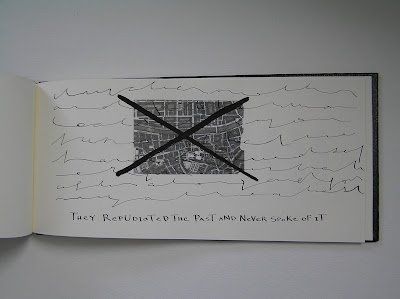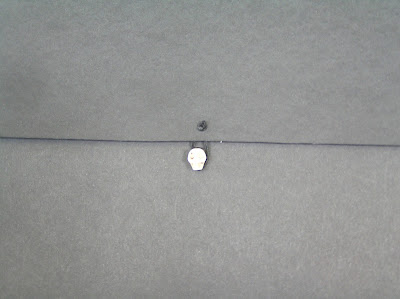Wishing you all a Merry Christmas and a Happy New Year.
Sunday 11 December 2016
Monday 8 August 2016
The Legacy of Absence and Silence
The Legacy of Absence and Silence
explores the search for identity and belonging, the desire to be part of a bigger shared history and cultural background. Many Australians whose forbears settled here from the early days of settlement throughout the 19th century share this absence of knowledge and this void.
These forbears never spoke of their families and their past lives in their native land. Many Europeans anglicized their names and rejected their native languages. Few stories, if any, were passed down, yet our identity is inextricably linked to these forbears through DNA.
When I started making this piece I first made a traditional book structure with a spine which I called
The Legacy of Silence.
I worked on pages using predominantly drawing, some printmaking and others using photo transfers.
This page was about gold mining, so a strip of real gold leaf was added.
The book works well but I always like an interesting sculptural presentation and I had in mind that I would enter this piece in the Libris awards, So I kept this book as a more traditional version and started again designing a large sculptural structure.
I needed to make a few changes and the printmaking pages were redone as white marks, drawing and a photo transfer on black paper.
I had to make a number of each of the pages as all the work had to be original artwork which could then be folded into long concertinas. I left the text off these pages and settled for a freestanding text page which folds into a concertina and sits within the front cover of the finished book.
The multiple concertinas were sewn together to form a more complex structure which still folds down flat into the book covers. It ended up being really large, measuring about 75 x 15 cm. closed.
The structure of the book enhances the meaning. The viewer can peer into the darkness of the front pages trying to glean details and then look down into the white pages where a few known facts are revealed, but glimpses only of these images can be seen, never the full story.
The Legacy of Absence and Silence has been selected for exhibition in the Libris Awards at Artspace Mackay from 26th August to 16th October 2016.
Tuesday 19 April 2016
The Future of an Illusion
called The Future of an Illusion.
This is a book about death - about the
processes the body goes through after death and the belief systems associated
with death.
When we began talking about
making the book, by chance I had recently read a book by Jim Crace
called Being Dead in which he documented the natural changes that occur in a
dead body left in nature and how it begins to decompose and return to nature.
This led to much discussion and Jack was immediately
enthusiastic about working with ideas about
decomposition and started experimenting in different ways with how he would
portray this. Research revealed that the body goes through
many changes of colour, some vivid and garish, as it begins to decompose and
regress from Zoology to Botany.
We wanted the book to be a bit sculptural and we
both agreed on including a void, which clarified our ideas about what we each believe happens after death and the definite decision that the void should lead nowhere. We cut spaces of descending size into card folded into a concertina to give it perspective and enable the viewer to look down through the void which was closed off at the end with the black card.
Around this time we discovered Sigmund Freud’s essay “The Future of an Illusion” in which Freud argued that an afterlife has no basis in science, is wishful thinking and a disavowal of reality. This reinforced the idea of our ‘void’ which had became a series of portals that lead nowhere.
I was interested in the immediate changes in the early days after death, and Jack had already started his experiments with decomposition, so it fell into place that I would work on a concertina which focused on the early stages and Jack would work on a concertina focusing on later stages of physical decomposition.
On the outside we used the blue/grey/green/silvery colours of the outside of the dead body.
On the outside we used the blue/grey/green/silvery colours of the outside of the dead body.
On the insides of the concertinas, like the inside of the body, we used reds and vivid colours.
The materials we used for the concertinas were acrylic, soluble carbon, gouache and ink on Arches 185 gsm watercolour paper. We each made four originals.
We wanted the book to look a bit scientific and Jack came up with a great method for image transfer which allowed us to use anatomical drawings.
I included a skull as an art historical reference to the Vanitas Still Lifes of the 17th century which reminded the viewer of the transience of earthly existence. Lines of text were randomly placed across the concertinas and the phrases were sourced from Being Dead by Jim Crace and The Future of an Illusion by Sigmund Freud.
Our structure was complete with a painted concertina sewn onto each side of the void concertina structure,
We had great ideas for presentation – things like a
zippered body bag made of black plastic, but in the end, due to the shape and
fragility of the book, we opted for a more protective four flap folder.
Jack had managed to come across some ‘skull’
buttons when he was in Tasmania recently and they were perfect for the closure
of the folder.
Monday 14 March 2016
Delires de Livres
I am very pleased to have been invited to participate in Delires de Livres once again.
I have been an exhibitor a number of times when the exhibition was held in the wonderful old Collegiale St Andre in Chartres in France. However the organisers were no longer able to exhibit in this location. Fortunately they were able to secure another venue - the new Cultural centre in Rambouillet which is on the outskirts of Paris. The only down side was that the number of participants had to be reduced from about 175 to about 65, so a much smaller exhibition this time.
It was no surprise that the book of mine that was selected is Rimbaud's Drunken Boat and is based on a French poem of that name - Le Bateau Ivre by Arthur Rimbaud. The book is made of triangles of perspex and is sewn together in such a way that it is flexible and can be displayed in a number of ways which can suggest the movement of the sea or the damaged boat.
Each perspex panel contains an etching which I made in response to a line of the poem and subsequently coloured with aquamarine acrylic. The book covers are of aquamarine perspex.
Delires de Livres 2016 will be on exhibition at La Lanterne in Rambouillet, France from 1st April to 21st May 2016.
Subscribe to:
Posts (Atom)
































